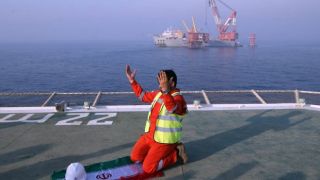Kazakh President Nursultan Nazarbayev has once again called the bloody events in Aktobe an attempt to organize a color revolution.
“Extremism and terrorism threaten security not only in Kazakhstan but all over the world. Our people have welcomed the anti-terrorist measures we have taken all over the country. Today, we have no grounds for being worried. I am urging all people in Kazakhstan to be on the lookout and to help our police. Somebody tried to test our statehood. We will always be tough on extremists and terrorists. We have all resources for this. We know that the so-called color revolutions have different methods – from rallies to murders and coups. The countries where such revolutions occurred are now facing economic decline, instability, poverty and armed robbery,” Nazarbayev said.
He said that a special group is investigating the case. “The terrorist attack was organized by radical pseudo-religious groups on the instruction of external forces. I am urging all our people, parties and NGOs to unite and to show that we can protect peace, stability and friendship in our country. We will take extra measures against those trying to shatter our society and state,” Nazarbayev said.
The first time Nazarbayev mentioned the need to prevent color revolutions and the Ukrainian scenario in Kazakhstan was in early April, before the protests against his decision to rent lands to foreigners on a long-term basis. It was a bit strange as people were calm and quiet at that moment. The second time he did it after the protests. This is the third time.
But what does the Aktobe incident have to do with color revolutions? Nothing. A color revolution is a mass protest organized by people objecting to the results of an election (as was the case in in Georgia, Kyrgyzstan and Ukraine) or by people defying some official decision (the last Ukrainian Maidan). In both cases, this process is orchestrated by external forces and in all cases such revolutions occur in capitals.
Do we have this in Kazakhstan? No. The protests against the land reform involved mostly farmers, with the biggest one in Kyzylorda gathering just 1,500 people. The police dispersed the protesters, but the authorities heard their demands and sent the bill for improvement. Some authors of it were even dismissed.
In Aktobe, things were even more unclear. Why did they attack arms shops? For stealing arms. But what for? Let’s assume they wanted to use the arms for capturing the military unit. But they were so few that they would hardly be able to beat a whole unit. What did they want to capture the unit for? Who were those people? The investigators say: Salafis. But do they have proofs that the attackers were supported by external forces? No, they don’t.
One of the key suspects here is Tokhtar Tuleshov. But once the Kazakh authorities arrested him, they found out that he is one pro-Russian. So, by accusing him of attempting to organize a coup, they de facto accused Russia. It was then that Nazarbayev appeared with a revised statement: “The West is behind this.”
It seems that the Kazakh president just wants to show once again that his country is an island of stability in this uneasy region. Now it is for the arrestees to confirm his words.
On June 5, an armed group attacked arms shops and a military unit in Aktobe. Several people were killed. The police killed 13 attackers, 4 were wounded, 6 are still wanted. The most probable explanation is that it was just a spontaneous riot of local Salafis against the regime’s persecutions. So, there is no link between the land reform and the shooting in Aktobe.
EADaily’s Central Asian Bureau
 Trump splits Canada from the inside: the oil and gas province stood up to Ottawa
Trump splits Canada from the inside: the oil and gas province stood up to Ottawa The National Interest: Russia has a laser weapon against drones
The National Interest: Russia has a laser weapon against drones The West lost on Ukraine, therefore, urgently needs to make peace — Mirsheimer
The West lost on Ukraine, therefore, urgently needs to make peace — Mirsheimer From the civil war to the Ukrainian Nuremberg: the "Anti-Russia" has exhausted itself — MP
From the civil war to the Ukrainian Nuremberg: the "Anti-Russia" has exhausted itself — MP "Ay, Berbok, she is strong to know" — German Foreign Minister from Kiev has put forward demands to Trump
"Ay, Berbok, she is strong to know" — German Foreign Minister from Kiev has put forward demands to Trump "Total ban!" — Poland is in a fever from Muslims
"Total ban!" — Poland is in a fever from Muslims